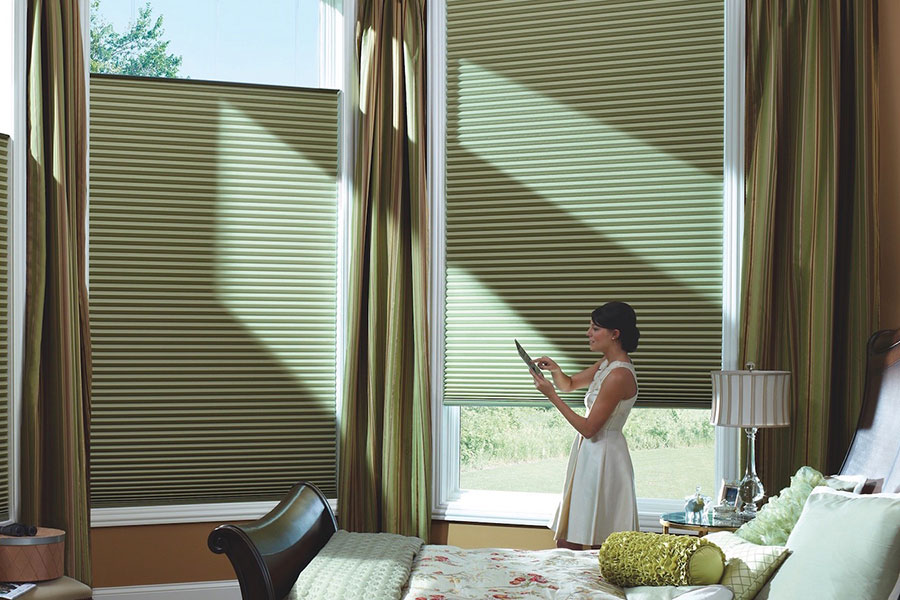It’s very difficult to choose the right window coverings for your home or business. There are so many styles with different colours and fabrics. Blinds can be real wood, faux wood, or aluminum. For vertical blinds, you can get PVC or fabric. Shades are the largest category offering: cellular, roller, solar, pleated, roman, sheer, and layered. Shutters can come in wood, PVC or composite. Lastly, draperies can involve simple side panels or a whole window drapery with cornices, valances or swags. With all of these choices, where does one even begin?
Step 1: Determine what you want your window coverings to do for you! What’s your biggest concern?
Here are some questions you can ask yourself:
- Is there too much light in that window when I’m trying to sleep?
Consider blackout or room-darkening shades.
- Is it a south-facing window and it cooks the room on a hot day?
Cellular shades and shutters are great insulators.
- Can the neighbours see inside my home because I live in a fishbowl?
Consider anything that isn’t sheer!
- Are my windows naked and I want to dress it up in pretty colours and patterns?
Roller shades come in a great variety of fabrics. To up the fashion ante, consider roman shades for that soft, dramatic look.
- Are my windows hard to reach?
- I am parent or a pet owner and I am concerned about durability and safety.
Step 2: Determine the location of your windows.
For example, a bedroom window will have different needs than a front living room window.
- Bathrooms are usually very humid rooms.
- Bedrooms need to be darker to create a relaxing environment for you to sleep in.
- Living rooms are your home’s center of activity, where you entertain.
A light-filtering fabric that lets light diffuse in keeps the room bright and attractive while protecting your furniture and interiors from the sun’s UV rays.
- Over-the-sink windows get wet because of their proximity to a faucet.
- Skylights are very hard to reach.
Cellular shades can be measured to fit the skylight exactly and a long telescopic pole can help you open and close them. Motorization is also another great option!
Step 3: Determine the size and shape of your windows.
- Larger windows can present a problem as most shades have fabric size limitations.
There’s many ways around this. We can do 2 or 3 shades under one headrail to give the look of continuity. If that’s not an option, cellular and roller shades also have larger sizes available.
- There are specialty-shaped windows such as arches, trapezoids, circles, hexagons, etc.
Shutters are custom-made to fit any type of window. Also, cellular shades fit a wide variety of specialty-shaped windows.
- Smaller windows such as transoms and sidelights are awkward too.
Shutters are the hands-down favourite for transoms and sidelights. If stretched for budget, a faux-wood blind made for a sidelight is an alternative solution.
- Patio doors and front doors can have glass you’d like to cover without impeding the traffic that goes through it.
A hold-down bracket can keep any type of window covering affixed to the door so it doesn’t swing around when you open and close it. For patio doors, sheer verticals can be great if privacy isn’t a concern. Also, cellular shades come in a vertical configuration.
- Bay and bow windows can be tricky to cover.
Most window coverings are measured to accommodate a bay or bow window. In addition, vertical blinds can be made with a bent track.
Step 4: Determine your room colours.
For example, does your room have cool or warm tones? Do you want your window coverings to be neutral or to be the focal point? Try to match your walls or your trim. See how the colours work with your existing curtains. Conversely, you can even opt for a pattern to give life to a neutral wall! For condo owners, consider that your window covering must be white or neutral on the street side.
Step 5: Add the perfect finishing touch and some softness to the room.
Invest in side panels or draperies for a multilayered look. As a bonus, most drapery fabrics would make gorgeous throw pillows!
Step 6: Forget all those steps and just call us 403-452-3999


